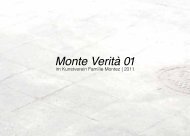Berlin Ausstellung: Der Tod 21. April – 19. Mai 2001
Berlin Ausstellung: Der Tod 21. April – 19. Mai 2001
Berlin Ausstellung: Der Tod 21. April – 19. Mai 2001
Erfolgreiche ePaper selbst erstellen
Machen Sie aus Ihren PDF Publikationen ein blätterbares Flipbook mit unserer einzigartigen Google optimierten e-Paper Software.
In der Moderne gab es bekanntlich zwei grundsätzliche<br />
Strategien des Überlebens. Durch den naiven Glauben –<br />
ohne wenn und aber – das Reich Gottes zu betreten,<br />
oder dem Gott den Rücken zu kehren und die Freiheit<br />
des Selbst zu genießen. Also, den Weg der Askese, oder<br />
den Weg der Apostasie. Im letzten Falle kam man an einigen<br />
verflixten Karamasowfragen nicht vorbei... z.B.<br />
"Und was nun?”.<br />
In der Postmoderne wurde die Suche nach Freiheit und<br />
Sinn im Allgemeinen zu einer erbärmlichen Angelegenheit.<br />
Die Kultur des 20. Jahrhunderts erreichte diesbezüglich<br />
das Endstadium an Fatalität. Man vertrieb sich<br />
die Zeit mit ”stinklangweiligen Geschichten über Leben<br />
und <strong>Tod</strong>” ("Malone”, S. Beckett), oder versuchte mit<br />
wechselndem Erfolg in der (Selbst)destruktion eine revolutionäre<br />
Intenz zu entdecken, um die Entfremdung in<br />
der Kultur zu überwinden (A. Artaud) und Gemüter aufzurütteln<br />
(Brus, Nitsch, Schwarzkogler). Die ultimative<br />
Konsequenz aus dem programmatischen Imperativ:<br />
”Kunst oder <strong>Tod</strong>” zog Ralf Schwarzkogler, der sich in seiner<br />
letzten ”Aktion” 1969 aus dem Fenster seiner Wohnung<br />
stürzte und starb.<br />
Irgendwann hat auch Andy Warhol erkannt, dass ”alles<br />
was er tut, mit dem <strong>Tod</strong> zu tun hat”. Viele seiner Bildserien<br />
befassten sich tatsächlich mit Selbstmorden, schweren<br />
Unfällen, dem <strong>Tod</strong>esstuhl, oder zeigten verstorbene<br />
(Marilyn Monroe) und schwerkranke Stars (Liz Taylor).<br />
Selber träumte der Künstler nach dem <strong>Tod</strong>e ins Warenstadium<br />
zu übergehen. Die Reinkarnation als Diamantenring<br />
an Liz Taylors Finger schwebte ihm so vor. Die "ewige”<br />
Haltbarkeit von Edelmetallen und -steinen bekam in seinen<br />
Phantasien eine metaphysische Konnotation.<br />
Nimmt man dagegen den heutigen Schönheitswahn und<br />
Jugendkult unter die Lupe, merkt man leicht, dass Menschen<br />
oft dem Zwang unterliegen, eine Warenexistenz<br />
bei Lebzeiten zu führen. Spielt man dieses Spiel mit, wird<br />
einem bereits in den "besten Jahren” ein "Verfallsdatum”<br />
aufgedrückt. Gutes Aussehen, sportliche Figur bestimmen<br />
die Position im Regal, sexuelle Qualitäten, Vermögen<br />
und (in Ausnahmefällen) intellektuelle Fähigkeiten,<br />
können die Position etwas verbessern, oder sogar<br />
das Verfallsdatum verlängern.<br />
Auch nach dem Ableben bestehen Chancen bewundert<br />
zu werden. Dr. Gunther von Hagens bietet allen Sterblichen<br />
die postmortale Perspektive als Replik eines bekannten<br />
Kunstwerks, in seiner Plastinatensammlung für<br />
Jahrtausende zu erstarren. Einem enthäuteten Läufer<br />
wehen Muskeln- und Sehnenfäden der futuristischen<br />
Idee vom puren dynamischen Gefühl entsprechend im<br />
Raum hinterher, gleichsam die Bewegungslinien fort-<br />
In the world of modernism, there were two basic survival<br />
strategies. One was to set foot in the divine kingdom<br />
through naive faith with no ifs, ands or buts; the other<br />
was to turn one's back on god and to enjoy to freedom<br />
of the self. One could choose between the path of asceticism<br />
and the path of apostasy. In the latter case, certain<br />
tricky Karamazov-questions could hardly be avoided...<br />
for an example: "And what now?"<br />
In the post-modern world, the search for freedom and<br />
meaning in general become a pitiful affair. In this context,<br />
20th century culture reached a final stage of fatality.<br />
One passed one's time with "dull stories of life and<br />
death" ("Malone", S. Beckett), or one more or less successfully<br />
attempted to find revolutionary intent in (self-)<br />
destruction in order to overcome the alienation of culture<br />
(A. Artaud) and to be provocative (Brus, Nitsch, Schwarzkogler).<br />
The ultimate consequence of the programmatic<br />
imperative "art or life" was faced by Ralf Schwarzkogler,<br />
who jumped to his death from the window of his apartment<br />
in his last "action" of 1969.<br />
At some point, Andy Warhol also realized that "everything<br />
[he] does has to do with death". Many of his series<br />
actually deal with suicides, serious accidents, and the<br />
electric chair. They also show stars that are dead (Marilyn<br />
Monroe) or ill (Liz Taylor). The artist himself also dreamed<br />
of becoming a commodity after his death, to be<br />
reincarnated as a diamond-ring on Liz Taylor's finger. In<br />
his fantasies, the "eternal" value of precious metals and<br />
stones was loaded with metaphysical connotations.<br />
If one examines today's mania of beauty and cult of youthfulness,<br />
one can easily recognize that people often<br />
compulsively become commodities or products while still<br />
alive. If one plays this game, one is already stamped with<br />
an "expiry date" in one's prime. Good looks and an athletic<br />
figure define the position on the shelf; sexual qualities,<br />
wealth and (as an exception) intellectual ability can<br />
improve this position somewhat or even prolong the<br />
commodity's shelf-life. Nevertheless, even after expiry,<br />
one still stands a chance of being admired.<br />
Dr. Gunther von Hagens offers all mortals the post mortal<br />
prospect of being frozen for millennia to come in his<br />
collection of plastinates as a replica of a well-known<br />
work of art. A skinned runner trails strings of muscles<br />
and sinew through the room, corresponding to the futuristic<br />
idea of pure dynamism, continuing the lines of<br />
motion. A further macabre quote, "Plastinate with<br />
Drawers", quotes a well-known painting by Dali. An absolute<br />
pièce de résistance is also on parade as a plastinated<br />
horse with a skinless rider, which may well be understood<br />
as a replica of the monument to Peter the Great on



